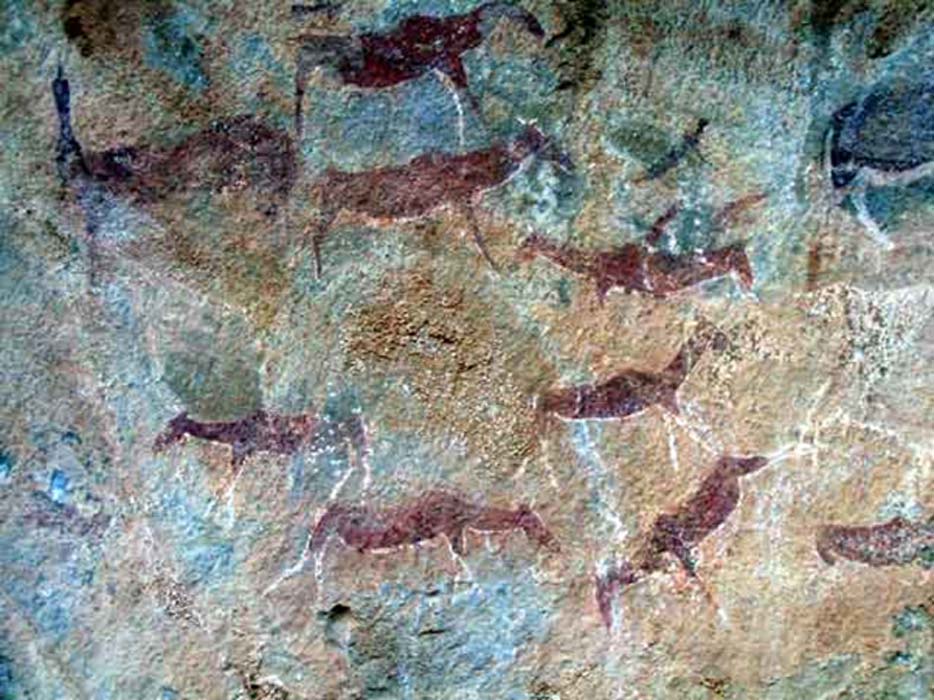Sacred Powers Fade Along With the Rock Art of the San People at Ha Baroana
As the world is getting smaller, thanks to technology and air travel, many previously mysterious, historic sites have become better known and it’s possible for ordinary tourists to visit these amazing locations once only viewed by explorers. These days visitors can easily travel to the fascinating, yet remote area in Lesotho which offers a window into the lives and minds of our ancient ancestors. This is the astounding Ha Baroana which is a major rock art location in the southern African nation and one of the most important sites of its kind in the Sub-Saharan region.
Who Were the Ha Baroana Artists?
There is no documentary evidence concerning the history of the cave and its rock art, however, the key to understanding the art is in its name: Ha Barona means the ‘home or dwelling of the Bushmen’ in the local language. The Bushmen are a unique cultural group with a distinctive language and they refer to themselves as the San People. They are among the first inhabitants of the region and have been living here for up to 40,000 years.

Ha Baroana, Lesotho. (Graham Maclachlan CC BY-SA 3.0)
The Bushmen or San People typically lived in hunter-gatherer groups and were nomadic. They were increasingly marginalized after the arrival of Bantu-speaking people and forced to live on peripheral lands or in semi-desert. Today, many San People have become farmers or moved to urban areas. It seems likely that the ancient artists who made the rock art were from a group of San and local traditions support this view.
Animals, People, and Their Way of Life
The San people have a very long tradition of rock art. There are examples of their art all over southern Africa, from Zimbabwe to the Republic of South Africa. The images were made by chipping rock away from the surface and applying pigments from natural ingredients to the carvings. The art at Ha Baroana represents a number of animals such as leopards, lions, elands, blue cranes, and other birds. Many of these species still inhabit Lesotho.
- The Lost Knowledge of the Ancients: Were Humans the First?
- Paleolithic Stone Slab Discovered in Spain May be the First Map of a Hunter-Gatherer Campsite
- Newly discovered Rock Art Heritage in the Kaimur Range of Bihar - India

San Bushwomen (Micklisch, M /CC BY 2.0)
It is believed that the rock art was made about 2000 years ago and some also depict the lives of the ancient San People. There are images of people hunting and dancing, as well as their huts. The scenes found in the cave are reminiscent of the lives lived by the San in Lesotho until fairly recently, and there are some groups in Namibia who still live in this manner.
Many of the stick-like figures are very faint and the etchings, which have been vandalized and neglected for years, have become a major concern for numerous groups involved.
Understanding the Ha Baroana Rock Imagery
The San tradition of painting is one which should not be compared to western notions of art. The carvings and rock images were not designed to be artistic, nor were they made for decorative reasons - the purpose was religious and spiritual and related to the shamanic beliefs of the San People. The imagery was an important factor in the ceremonial and ritual aspects of their lives and these figures of people and animals were possibly designed to ensure the success of the all-important hunt.

Other San rock art in southern Africa, men with shields (CC BY 4.0)
An alternate theory states that the etchings were representations of mythical gods and heroes. However, much of the ancient knowledge of the religion and mythology of the Bushmen has been lost due to the impact of the modern world and especially the influence of Christianity. It is also likely that the etchings were important in folk-medicine or used to demarcate geographical boundaries, marking out a space for social or religious reasons.
Getting To the Ha Baroana Carvings
The extraordinary etchings are located some 30 miles (48 km) to the east of the capital of Lesotho, not far from the village of Nazareth. The art is in a rock shelter, a shallow cave-like feature formed by an overhanging cliff. To reach the etchings, which are well sign-posted, visitors needs to follow a path down the hill, but it is also possible to get dropped off close to the site by taxi.
Top image: The eland of Ha Baroana. Source: TravelLesotho.com
By Ed Whelan
References
Cherry, M. A. (1982). Bibliography of rock art in Natal and Lesotho: 1874-1981. Annals of the Natal Museum, 25(1), 173-220
Available at: https://journals.co.za/content/annals/25/1/AJA03040798_527
Lee, R. B., Daly, R., & Daly, R. H. (Eds.). (1999). The Cambridge encyclopaedia of hunters and gatherers. Cambridge University Press
Lee, Richard; Irven DeVore (1999) Kalahari Hunter-Gatherers: Studies of the ǃKung San & Their Neighbors. iUniverse
Available at: http://www.hup.harvard.edu/catalog.php?isbn=9780674430600



















